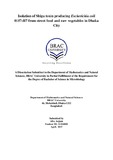| dc.description.abstract | E. coli O157:H7, a Shiga toxin producing microbe was first acknowledged as a virulent organism in 1982 during an analysis of an outbreak of haemorrhagic colitis associated with consumption of hamburgers from a fast food chain restaurant. An inspection of more than three thousand E. coli cultures collected between 1973 and 1982 showed only one isolate with a serotype O157:H7. In the following ten years, there were just about thirty outbreaks documented in the United States. It is assumed that there might have been more cases, but remained unreported since an outbreak could not be detected as the number of affected was not large enough to lead it into an investigation. Ability of E. coli O157:H7 to induce injury in humans is a result of its ability to produce numerous virulence factors, most notably Shiga toxins Stx1 and Stx2, both of which constitute one of the most potent toxins known to man. Endothelial cells line the interior surface of blood vessels, and are known to be tremendously susceptible to E. coli O157:H7, which is cytotoxigenic to these cells. Besides, Shiga toxin, E. coli O157:H7 produces several other virulence factors, which include proteins which aid in the attachment and colonization of the bacteria in the intestinal wall and which can break down red blood cells and release iron to help support metabolism in E. coli . Virulence factors facilitate this organism’s ability to cause intestinal and extra-intestinal diseases such as diarrhoea, haemorrhagic colitis (HC), haemolytic uremic syndrome (HUS), urinary tract infections (UTI), septicaemia and neonatal meningitis. Street foods and raw vegetables are infamous for the lack of hygiene and potentially hazardous microbial quality. Ingestion of these foods may lead to diarrhoea. In this study r, 6 samples from Dhaka city was collected, cultured in various media for enumeration, isolation and screening of E. coli colonies which were further analysed to check for the presence of stx genes using PCR and gel electrophoresis. The six samples collected were: Salad, Fruit Mix, Sugar Cane Juice, Betel leaves, Pulse (from Bhelpuri) and raw coriander. The samples collected initially were enriched in enrichment media overnight, followed by a 6 fold dilution series which were then used for spread plating on nutrient agar and MacConkey agar. Pink colonies screened from MacConkey agar plates were streaked on EMB for confirmation with the observation of metallic sheen. The confirmed E. coli isolates were later subjected to DNA extraction and amplification after which the bands for stx genes were observed and recorded. Out of the six samples tested for stx1 and stx2 genes, four showed the presence of stx2 genes, which in many papers have been mentioned as the more virulent gene out of the two. The presence of the stx2 genes in regular food signifies how close we are to a large outbreak. Knowledge of processing such food or avoiding when possible may prevent occurrence of foodborne diseases. | en_US |

